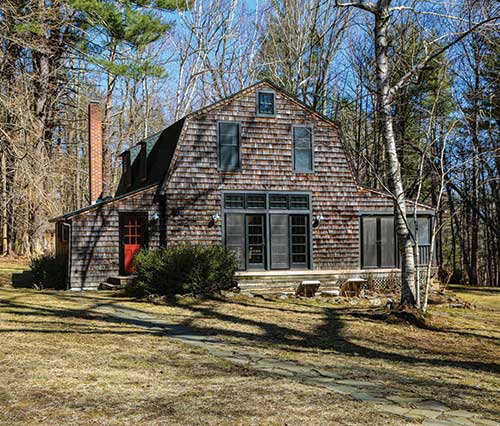Real Estate

COVID-19 Impact
As I write this article in mid May, restrictions on real estate agents in New York, Massachusetts, and Connecticut to physically show properties to potential buyers remain in force. Residents are still under distancing, masking and quarantine orders, busy village streets are empty, bars are closed, groceries are delivered. Everyone is wondering how long this will last and what the impact on our economy and the real estate market will be. Like COVID-19 test results, figuring out what is happening right now in the national and local real estate markets – or what the future holds – is at best thoughtful guesswork.
Will the viral economic storm affect national real estate prices?
Consider the grim economic news. Economists surveyed by the National Association for Business Economics expect a short, deep recession with the economy shrinking 26.5% in the second quarter with a turn-around in the last half of the year. Others, like the International Monetary Fund, expect the worst recession since the Great Depression. Stock market indexes, historically, a leading indicator of economic activity, hit bottom on March 23 and have bounced up and down, although still well below the high in February.
More than twice as many Americans lost their jobs in April alone than in two years during the Great Recession. The national unemployment rate in May is expected to reach 25% – a rate not seen since the Great Depression.
Consumer spending in March plunged 7.5%, the largest one-month decline since the government started tracking this measure in 1959. April’s decline won’t be released until the end of May but is expected to be even worse. Consumer confidence has tumbled to its lowest level in six years.
An estimated one third of apartment renters didn’t pay their rent the first week in April. Staples has informed its landlords it will not being paying rent in April even though stores remain open. Other big retailers, like H&M are also refusing to pay rent. Many large businesses are discovering that working remotely saves money and intend to permanently shift at least part of their work force to home offices. Commercial real estate will clearly suffer short and long term as a result of COVID-19.
Nationally most real estate professionals are optimistic – as usual
Most frequently quoted real estate executives regard the COVID-19 response as very different from the financial crisis of 2008-2009, which was created, in part, by sub-prime lending. Right now there is no over supply of housing like a decade ago. There is actually a housing shortage, an imbalance of houses available for sale and great demand from buyers, especially in the low and mispriced market.
 Vacancy rates across the country are at a 35-year low and falling. In contrast to 2007/2008, homeowners’ equity is much healthier and housing prices aren’t overvalued in general. The housing market nationally was strong as COVID-19 arrived with rising median home prices.
Vacancy rates across the country are at a 35-year low and falling. In contrast to 2007/2008, homeowners’ equity is much healthier and housing prices aren’t overvalued in general. The housing market nationally was strong as COVID-19 arrived with rising median home prices.
This optimism about recovery from lock down is based in part by government policies. The Federal Reserve Bank is expected to maintain near zero interest rates through 2021. This means attractive low mortgage rates, which should support real estate values. The government’s offer of extended repayment options for homeowners with federally backed mortgages should minimize the domino effect that foreclosures can have on home values. The Cares Act applies specifically to the roughly 75% of all mortgages in America that are backed by Freddie Mac, Fannie Mae, or other government agencies.
But there are also more cautious observers who offer a dose of reality. They ask if large national real estate firms like Compass and Realogy are cutting executive pay and furloughing employees, should we really expect a quick bounce back? These pessimists feel that both buyers and sellers will remain cautious for a while.
In early April members of the National Association of Realtors said buyers were delaying home purchases for a few months and new listings on Zillow were down 40% from last year, reflecting the hesitancy of sellers to put their homes on the market. Zillow, which is forecasting a 4.9% decrease in US GDP in 2020 with a 5.7% increase in 2021, predicts that nationally home prices will fall 2% through the end of the year.
Realtor.com’s latest forecast predicts that home sales will fall by as much as 15% by year end after a rebound in July. While real estate markets nationally may return to normal activity in the last half of the year as restrictions are gradually lifted, the hardest hit regions like New York and Connecticut may recover more slowly because of high unemployment and limitations on movement. This is especially true in New York City where real estate was already slow going into the spring season with record inventory and Manhattan prices falling for a third year in a row.
BUT “Never been so crazy busy”
Despite limitations on showing and even photographing houses, residential sales activity in just the first week of May saw five closings in the town of Salisbury compared to last year when there were seven in the entire month! Most agents in Connecticut and New York report that they have never been so busy fielding calls from buyers and sellers. Buyers who were on the fence before have suddenly become serious. New buyers have appeared. Short-term and summer rentals have already been taken and increasingly, those who want to rent to get out of the city for a while are realizing they may have to commit to a year round lease.
The COVID-19 situation, like 9/11, combined with today’s technology has brought increased interest in our local markets. The pandemic has accelerated the working remotely, working from home trend. Before this pandemic started, less than 4% of all Americans worked full-time from home. Now that figure has jumped to half of all employed workers, reaching 70% for those with desk jobs. Many companies, like Goggle, have already informed staff that they’ll be home through Christmas. This is not a short-term phenomenon and urbanites are now seeking homes with more breathing space.
Working from home means a greater need for larger living spaces with flexible rooms to use as office space. We’re doing everything from home now – schooling our children, exercising, cooking and working. The Millennial generation, after grazing on airbnb weekends, is finally searching for a permanent home. The country, two hours from New York City, seems like a very sensible idea. The desire to buy a ready-to-move-in home with no renovations has only grown stronger for two reasons. Buyers want to move in now and contractors are less available to do work
The brake on sales is low inventory of homes for sale in our region. In the corners of our four county, three state, real estate market there was no March or April rush to put houses on the market for spring selling season.
Three years of market activity in Salisbury, Sharon, and Kent in CT as a representative sample, demonstrates this trend. New listings in March and April in 2020 and end-April inventory are all 25% below 2018 levels. This year the buying season may shift from spring to fall as sellers decide what to do.
In response to the lock down, virtual showings and contactless sales are occurring. One high-end realtor said she has three closings scheduled in the next month and she has never met the buyers. Technology, not just the virus, is transforming the real estate industry.
The biggest wildcard is the unknown of how long it will take to control the spread of the virus and what the responses will be. In a way, uncertainty about what the future holds is actually positive in the long-term for our market. New buyers are flocking to our market. How long will social distancing and working from home last? What will be the long-term effect of today’s unemployment rates? No one knows, but this seems a very good place to live. •
Christine Bates is a real estate agent with William Pitt Sotheby’s International in Salisbury, CT. She is one of Main Street’s founding writers and has delved into real estate topics since Main Street’s first issue.





